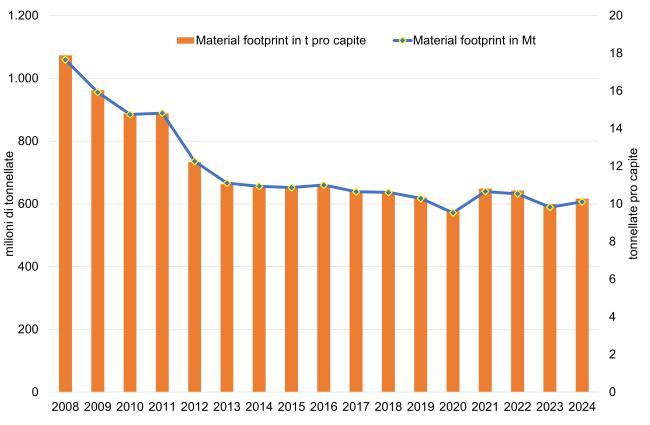Panel 1
Cristina Frizza
Italy has structurally reduced its material footprint, going from 17.9 to 10.3 tonnes per capita between 2008 and 2024, reaching values lower than the EU average. This result reflects significant progress in terms of efficiency and circularity, but it requires consolidating the decoupling between economic growth and resource consumption in order to make the competitive advantage durable.
For a more complete evaluation of the material flows connected to the functioning of an economy, it is appropriate to consider, in addition to domestic material consumption and resource productivity, also those flows necessary to produce imported and exported goods and services. These are the indirect flows, i.e., the part of the so-called ecological rucksack that is transformed into waste or emissions.
A more comprehensive picture can be provided by expressing imports and exports in “material (natural) resources (used) equivalents”, known in the international literature as “raw materials equivalents” (RME). For example, the RME of a given quantity of cereals traded abroad consists, in addition to the cereals themselves, also of what was necessary to extract to produce all the products (goods and services) used as inputs (intermediate consumption) in cultivation activities, such as the oil used to produce fuels for agricultural machinery and the raw materials from which fertilizers spread on the soil are derived.
It is important to note that the part of RME that is not physically contained in the imported goods and services has become, abroad, residual returned to the natural environment or waste accumulated in landfills. This part constitutes the indirect flow of imports. The same applies to exports.
If, in addition to the direct flows with abroad, the indirect flows are also considered, i.e., the resources extracted and used for the production of goods and services traded abroad, the imports and exports in RME are obtained.
The indicator measures the total amount of raw materials extracted to meet the domestic demand of the economic system, i.e., it quantifies the extraction of natural resources — biomass, metal ores, non-metallic minerals, and fossil fuels — globally due to the final consumption and investments of households, companies, and public administration in Italy.
The purpose is to evaluate the amount of raw materials used to meet domestic demand, providing a representation of the impact of resource use, including materials extracted within the country and those indirectly used abroad to produce the imported good.
-
Panel 2
- Documentation of the EU RME Model. Eurostat, Octaber 2024
( D351A43D-4298-C681-64AF-F94E1Fabecea
- Handbook for estimating raw material equivalents of Imports and exports and Rme-Based Indicars on the country level, based on Eurostat's eu Rme Model. Eurostat, Novemberfebray 2024 ( https://ec. europa. eu/eurostat/documents/1798247/6874172/handbook-bounttry-me-tool
The estimates derive from the application of an economic-environmental model provided by Eurostat. The model is susceptible to further developments considering the ongoing methodological comparisons at the international level for this type of estimates. The derived estimates constitute experimental statistics as they are characterized by high statistical uncertainty.
Data quality assessment
Eurostat (Statistical Office of the European Communities)
Eurostat: https://ec. europa. eu/eurostat/web/main/data/database
National
2008-2024
Indicator assessment
The calculation of “upstream” material requirements can be carried out in various ways, mainly based on Life Cycle Analysis input inventories, or on the more comprehensive, but much less detailed, Input-Output model used in economic analysis. Often the two methods are “hybridized”, as in the case of the basic-structure Input-Output model provided by Eurostat for estimating direct and indirect material flows related to foreign trade.
In 2024, Italy’s material footprint stands at about 606 million tonnes, equal to 10.3 tonnes per capita. This value is lower than the EU average (14.1 tonnes per capita), confirming Italy’s position among European countries with a lower intensity of material resource use relative to population. This trend partly reflects the national production structure, characterized by a relatively limited weight of high material intensity industries and a higher incidence of the services sector and light manufacturing.
Between 2008 and 2024, the Italian material footprint recorded a significant reduction, going from over 1 billion tonnes (17.9 tonnes per capita) to just over 600 million tonnes (10.3 tonnes per capita), with an overall decrease of about –43% in absolute terms and –42% per capita, outlining a positive trend (Figure 1, Table 1).

The material footprint represents a key indicator for measuring the pressure that the economic system exerts on the environment in terms of total natural resources used, including not only materials extracted nationally but also those incorporated in goods and services imported from abroad. For this reason, it is an essential tool for evaluating progress towards a circular economy model, capable of reducing dependence on primary resources and limiting environmental impacts related to material consumption.
The data available for Italy show a significant and structural reduction of the material footprint in the period 2008–2024: from about 1,059 million tonnes in 2008 (17.9 t/cap) it decreased to just over 606 million tonnes in 2024 (10.3 t/cap), with a contraction of over 40% in absolute terms and a similar reduction in per capita values. This dynamic reflects several factors: the effects of the 2008–2013 economic-financial crisis, which sharply reduced production and consumption; the growing diffusion of production models with lower material intensity, partly linked to the transformation of the industrial structure and the greater weight of the services sector; the consolidation of recovery, recycling, and waste reduction practices, in line with EU circular economy objectives.